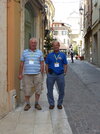I find knees an interesting subject, by the time I had reached the age 72 I had systematically managed to destroy both of mine, mainly from sport at a very early age, and then football, road running, squash until around 40 years of age, and of course kicking over Vincent motorcycles didn't help the situation. After several surgical procedures to both knees over the years my knees were both destroyed, so replacement was the only option.
The build up to the knee replacement operations initiated some interesting conversations with my chosen surgeon, one such conversation being, when looking at the new components that were soon to be residing in my legs was "I can't see how the ACL (anterior cruciate ligament) will attach to the new knee components" I was told they don't, I thought that is very strange, apparently it is the most important soft tissue structure within the knee joint, and its main role is maintaining stability of the knee during all motions, so how can it not be re-attached, well apparently it gets discarded, along with all the other worn out parts, remaining cartilage and some bone, so how does the new knee joint maintain stability, well the replacement joint components, along with the remaining muscles and tendons and ligaments take care of that.
So back to flexion, , most of us will have in young adult life around 135-150 degrees of flexion, and 5 degrees of that can be a negative figure to start with, in other words when your leg is fully straightened and your knee locked, your leg will be straight, plus a bit more, so over straight by 5 degrees, and fully flexed 130-145, now if you can achieve that figure after knee replacement surgery you will be doing very well indeed, but you should be able to get somewhere near to that.
As far as activities go, and I do mean normal activities for a septuagenarian, my surgeon advised against taking up running again as the forces on the knee are so great, you could knock your new knee out prematurely. Exactly a year after my ops I walking on Ilkley Moor when I slipped on ice, and my legs collapsed under me, I think on that occasion I achieved the absolute maximum knee flexion that is possible, and it was extremely painful at the time, and for a few days after, thankfully it all calmed down after a while, but I was extremely worried about long term damage, thankfully that proved not to be the case, at the cost of a decent Vincent Rapide, I would prefer not have the procedure repeated.
The build up to the knee replacement operations initiated some interesting conversations with my chosen surgeon, one such conversation being, when looking at the new components that were soon to be residing in my legs was "I can't see how the ACL (anterior cruciate ligament) will attach to the new knee components" I was told they don't, I thought that is very strange, apparently it is the most important soft tissue structure within the knee joint, and its main role is maintaining stability of the knee during all motions, so how can it not be re-attached, well apparently it gets discarded, along with all the other worn out parts, remaining cartilage and some bone, so how does the new knee joint maintain stability, well the replacement joint components, along with the remaining muscles and tendons and ligaments take care of that.
So back to flexion, , most of us will have in young adult life around 135-150 degrees of flexion, and 5 degrees of that can be a negative figure to start with, in other words when your leg is fully straightened and your knee locked, your leg will be straight, plus a bit more, so over straight by 5 degrees, and fully flexed 130-145, now if you can achieve that figure after knee replacement surgery you will be doing very well indeed, but you should be able to get somewhere near to that.
As far as activities go, and I do mean normal activities for a septuagenarian, my surgeon advised against taking up running again as the forces on the knee are so great, you could knock your new knee out prematurely. Exactly a year after my ops I walking on Ilkley Moor when I slipped on ice, and my legs collapsed under me, I think on that occasion I achieved the absolute maximum knee flexion that is possible, and it was extremely painful at the time, and for a few days after, thankfully it all calmed down after a while, but I was extremely worried about long term damage, thankfully that proved not to be the case, at the cost of a decent Vincent Rapide, I would prefer not have the procedure repeated.
Last edited:

